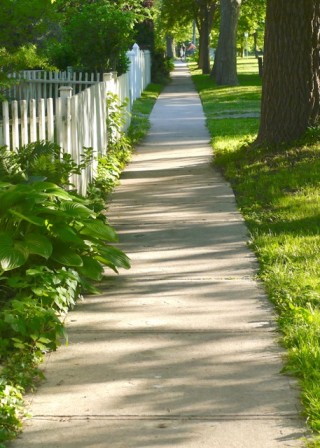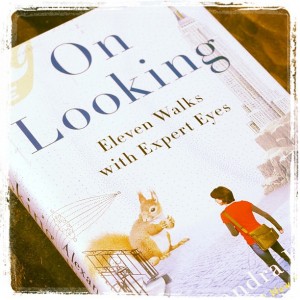Inspired by this book review from Brain Pickings, I was excited to read On Looking: Eleven Walks with Expert Eyes (paid link) by Alexandra Horowitz (paid link). And, it was a thoroughly enjoyable and fascinating read from beginning to end.
Right now, you are missing the vast majority of what is happening around you. You are missing the events unfolding in your body, in the distance, and right in front of you. ~ Opening Paragraph, On Looking
 In my photography classes, we usually focus on one theme per week. For example, in the first week of Photo By Design, we notice light. Participants are always amazed at what they see – what’s been there all along yet taken for granted.
In my photography classes, we usually focus on one theme per week. For example, in the first week of Photo By Design, we notice light. Participants are always amazed at what they see – what’s been there all along yet taken for granted.
Through selective attention, we heighten awareness of the topic.
You’ve probably seen this happen in your own life. You read about something that captures your attention and then suddenly it starts to pop up everywhere. It’s not that it wasn’t there before, it’s that you’ve placed your attention in that direction.
The premise of Horowitz’s book is that we miss so much of our surroundings because a) we aren’t knowledgeable enough to know what’s there or b) we haven’t decided to place our attention there.
Horowitz walks with eleven “experts” in different fields who show her what they see – her 18 month old son, a geologist, a typographer, an illustrator, a naturalist, a wildlife scientist, an urban sociologist, a doctor, a blind person, a sound designer, and her dog. Each brings specialized knowledge and their own unique way of looking at their surroundings.
Here are a few highlights that were shifts in perspective for me.
When Horowitz walked with her son, she had her own aha moment. We think of a walk as navigating from point A to point B. She learned from her son, though, that the walk begins before even leaving the house, in the putting on and tying of shoes.
A walk is an investigatory exercise that begins with energy and ends when (and only when) exhausted… A walk is exploring surfaces and textures with finger, toe, and – yuck – tongue, standing still and seeing who or what comes by; trying out different forms of locomotion. It is archaeology: exploring the bit of discarded candy wrapper; collecting a fistful of pebbles and a twig and a torn corner of a paperback; swishing dirt back and forth along the ground. It is stopping to admire the murmuring of the breeze in the trees; locating the source of the bird’s song; pointing. Pointing! – using the arm to extend one’s fallen gaze so someone else can see what you’ve seen. It is a time of sharing. ~ Muchness, On Looking
Horowitz walked with Fred Kent, an expert on public spaces, through one of her least favourite places – Broadway in the Village. I could relate to her pain when she was annoyed with the slow moving pedestrians. I’ve felt that same annoyance with the tourists in Niagara-on-the-Lake. What bothers me is their total unawareness that stopping in the middle of the sidewalk might affect the people around them.
For Kent, however, this experience of everyone being slowed is a positive quality for an urban space. And, not just for shopping purposes. Kent says that a sense of slowing down and loitering creates a relaxed, social experience, even though it may be an impediment to someone like me who has a destination in mind. This caused Horowitz (and me) to remember that there are many ways to look at any given situation.
Might we look at pedestrians not just with tolerance, or with acknowledgement of their role in making the city rich, but also as impressive collaborators in an unlikely sidewalk dance. ~ A Nice Place to Walk, On Looking
And finally, walks with my dog, Daisy, will never be the same after reading this book. I always thought that if we walked at Daisy’s pace, we would never get anywhere. And wasn’t she only stopping to smell the remnants of other dogs? After reading the chapter on what dogs actually smell – much more than urine – it’s made me realize that I could be learning a lot more about what there is to see and smell and feel on our walks.
To the dog, smells are simply information. Their world has a topography wrought of odors; the landscape is brightly colored with aromas. ~ A Dog’s Nose View, On Looking
Ideas for photo walks on a theme.
* Insects and Animals – look for nests, lairs, and other animal homes. Turn over rocks or poke through straw or grasses looking for insects.
* People – sit in a public space and watch what people do, how they’re dressed, how they walk.
* Signs and Lettering – notice typography, color, placement, grammar, etc.
 * Rocks and Stone – hold the history of a place. How many different types and sizes can you find?
* Rocks and Stone – hold the history of a place. How many different types and sizes can you find?
* Buildings – look at building materials, architectural elements, how they intersect with nature. Photograph reflections in glass.
* Public Spaces – look at size, design, what they are made of. How do people use the space?
* Sounds – focus on listening as you walk. What do you hear? How does listening intently change what you see?
* Smells – same as listening, just focus on a different sense. How does smelling intently change what you see?
Related Reading
Human Libraries (thanks to Lauren O’Malley for this)
People in Motion, the Parkour Documentary (amazing)
How to Be an Explorer of the World by Keri Smith
What fun ideas for photo walks, Kim! I think I’ll try some of them this week — thanks for sharing. And the book sounds like a good read.
The book is a really fun read, Gina. And, I am going to do some of those photo walks too.
Lovely inspirational ideas on things to notice when we’re out walking. Sounds and smells are a new idea for me. Love the idea!
That quotation from John Burrough’s is perfect! The art of seeing things anew that we pass by regularly! I like the look of that book.
That pretty street that heads this blog post reminds me of the street in Niagara-on-the-Lake when I visited the Trisha Romance art exhibition last September!
Thanks for the book review and the great ideas for photo walks. I have a couple of photography friends here locally, and we are always trying to come up with new ideas for our “meetups” and photo walks.
You always read the most interesting books! Thanks for the review and the photo-walk ideas. You ended this with one of my favorite quotes.
I found this a fascinating concept. It’s all too easy to screen out the familiar and notice only what is different or annoying. How much better to start out with an intention to seek out and appreciate certain things.